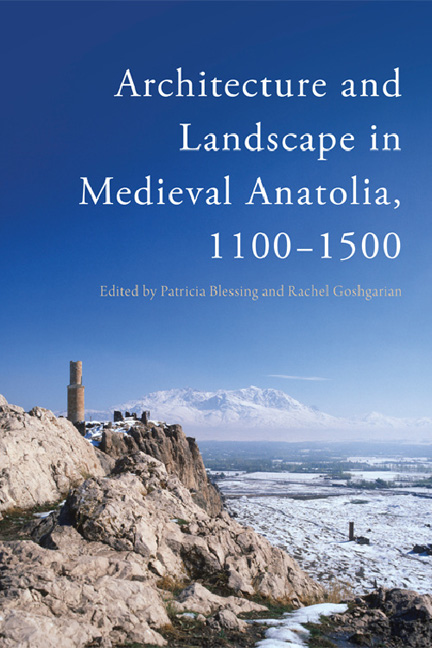Book contents
- Frontmatter
- Contents
- List of Illustrations and Tables
- Acknowledgements
- Foreword
- Map
- 1 Introduction – Space and Place: Applications to Medieval Anatolia
- Part I Building: Masons and Infrastructure
- Part II Social Groups: Akhis and Futuwwa
- Part III Exchange: Islamic and Christian Architecture
- 6 Transformation of the ‘Sacred’ Image of a Byzantine Cappadocian Settlement
- 7 The ‘Islamicness’ of Some Decorative Patterns in the Church of Tigran Honents in Ani
- Part IV Frameworks: Language, Geography and Identity
- Notes on Contributors
- Bibliography
- Index
6 - Transformation of the ‘Sacred’ Image of a Byzantine Cappadocian Settlement
from Part III - Exchange: Islamic and Christian Architecture
Published online by Cambridge University Press: 03 January 2018
- Frontmatter
- Contents
- List of Illustrations and Tables
- Acknowledgements
- Foreword
- Map
- 1 Introduction – Space and Place: Applications to Medieval Anatolia
- Part I Building: Masons and Infrastructure
- Part II Social Groups: Akhis and Futuwwa
- Part III Exchange: Islamic and Christian Architecture
- 6 Transformation of the ‘Sacred’ Image of a Byzantine Cappadocian Settlement
- 7 The ‘Islamicness’ of Some Decorative Patterns in the Church of Tigran Honents in Ani
- Part IV Frameworks: Language, Geography and Identity
- Notes on Contributors
- Bibliography
- Index
Summary
Until recently, there were two popular misconceptions in the academic community related to Byzantine Cappadocia, the region in central Turkey: (1) that Cappadocia was a Byzantine monastic centre; and (2) that the history of Byzantine Cappadocia came to an end with the arrival of the Seljuks in the last quarter of the eleventh century. Accordingly, convinced of the inordinately generalised monastic identity of the region, scholars had initially categorised the settlement of Acıksaray in Cappadocia as a monastic site that dates back to the tenth and eleventh centuries, although literary and physical evidence is absent. At the other extreme, while advocating a secular purpose, Thomas Mathews and Anna-Christine Daskalakis-Mathews suggest that the inverted T-plan scheme and decorative elements of the rock-cut facades of those in Acıksaray and similar complexes in the region are secular Islamic in origin. The dual character of the settlement of Acıksaray, which apparently bears both Christian and Islamic features, is also strengthened by legends that put the settlement in connection with Hacı Bektaş Veli, the founder of the Bektaşi Sufi order in the thirteenth century, who was settled in Sulucakarahoyuk (today Hacıbektaş), just 30 km north of Acıksaray.
Acıksaray's diverse architectural vocabulary and entangled identities can be directly linked with its location between the Christian and Islamic worlds. Paying particular attention to this, and to the impact of prior scholarship on the formation of these identities, this chapter will discuss the invention of a ‘sacred’ Christian image of a secular Byzantine site that emerged on a medieval border, as well as the adaptability and transmission of this image of a non-Muslim site in an Islamic land up to the present day, through Acıksaray.
Cappadocia is the name commonly given to a particular area in central Anatolia with boundaries that have been drawn and redrawn on many occasions throughout its history. Cappadocia can be defined as an area of unique geological formations that have been subjected over time to intensive rock-cut architectural activity (Plate 7). The boundaries of this idiosyncratic volcanic landscape can be marked by the contemporary cities of Aksaray, Nevşehir, Kayseri and Nicde in present-day Turkey (Figure 6.1).
- Type
- Chapter
- Information
- Architecture and Landscape in Medieval Anatolia, 1100-1500 , pp. 135 - 154Publisher: Edinburgh University PressPrint publication year: 2017



